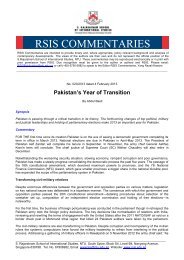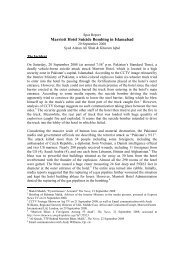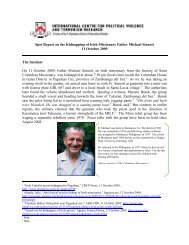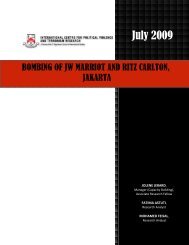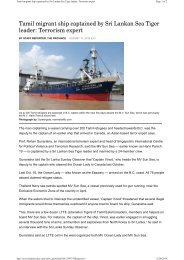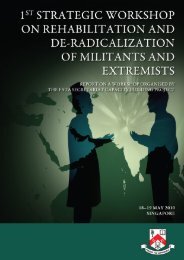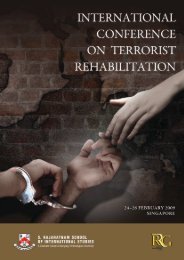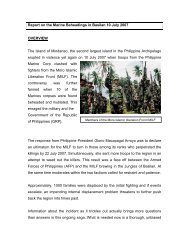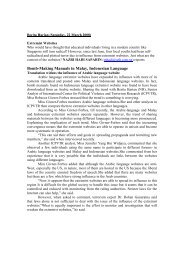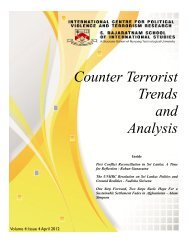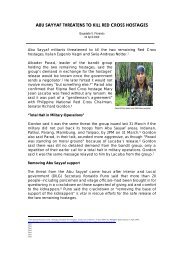Peace and Security Review, Vol.1 No. 2 - International Centre for ...
Peace and Security Review, Vol.1 No. 2 - International Centre for ...
Peace and Security Review, Vol.1 No. 2 - International Centre for ...
Create successful ePaper yourself
Turn your PDF publications into a flip-book with our unique Google optimized e-Paper software.
Summaries vii<br />
<strong>Peace</strong> <strong>and</strong> <strong>Security</strong> <strong>Review</strong><br />
<strong>Vol.1</strong>, <strong>No</strong>.2, Second Quarter, 2008, pp. vii-ix<br />
Summaries<br />
Making <strong>Peace</strong> with Pakistani Taliban to Isolate Al-Qaeda:<br />
Successes <strong>and</strong> Failures<br />
Rohan Gunaratna <strong>and</strong> Syed Adnan Ali Shah Bukhari<br />
The Federally Administered Tribal Areas (FATA) of Pakistan has become the<br />
epicentre of international terrorism in recent years. Located along the 2,400<br />
km long rugged border separating Afghanistan <strong>and</strong> Pakistan, FATA has<br />
provided Al-Qaeda, the most hunted terrorist group in the world, with a robust<br />
<strong>and</strong> resilient sanctuary. According to the US Department of State’s Country<br />
Reports on Terrorism 2007 released on 30 April 2008, FATA has provided Al-Qaeda’s<br />
leadership with “greater mobility <strong>and</strong> ability to conduct training <strong>and</strong> operation<br />
planning, particularly that targeting Western Europe <strong>and</strong> the United States.”<br />
This paper attempts to analyze the peace agreements signed by the Pakistani<br />
government with the Tribes <strong>and</strong> militants in South <strong>and</strong> <strong>No</strong>rth Waziristan<br />
Agencies between 2004 <strong>and</strong> 2006. It progresses to discussing the post-peace<br />
agreement situation arising in the Waziristan Agencies <strong>and</strong> its impact on the<br />
security of Pakistan. Particular stress is laid upon the need <strong>for</strong> a developmental<br />
response including humanitarian projects, to fighting both terrorism <strong>and</strong> insurgency<br />
emanating from the region in question <strong>and</strong> garnering <strong>and</strong> sustaining,<br />
public support <strong>for</strong> the government’s campaign against such elements.<br />
Post-Cold War Great Power <strong>Security</strong> Dynamics in the<br />
Asia-Pacific Region<br />
S. Mahmud Ali<br />
The end of the Cold War <strong>and</strong> the coterminous implosion of the Soviet Union<br />
in the early 1990’s marked a dramatic transition at the global strategic ‘centre.’<br />
The Cold War, which hinged on a nuclear peace, was a potentially unstable<br />
system. The fear was that in the event of a temporary superiority, the other<br />
could launch a first strike, destroying deterrence <strong>and</strong> initiating a devastating<br />
escalatory chain. The Cold War’s sudden <strong>and</strong> largely unanticipated end<br />
robbed the system of that acute clarity <strong>and</strong> bipolar structure. Uncertainty<br />
injected fluidity into the system <strong>and</strong> the transition to successor architecture is<br />
Vol. 1, <strong>No</strong>. 1 2008 pp. i-vi




